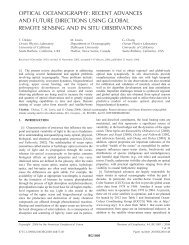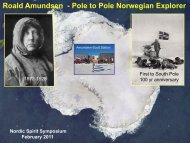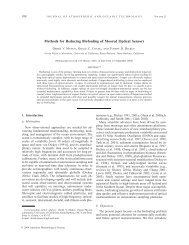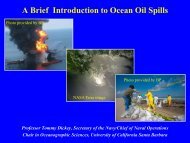Tsunamis
Tsunamis
Tsunamis
Create successful ePaper yourself
Turn your PDF publications into a flip-book with our unique Google optimized e-Paper software.
<strong>Tsunamis</strong>: Understanding and<br />
Preparing for the Ocean‟s Fury<br />
Nordhoff High<br />
April 15, 2011
Part 1 Questions<br />
What is a tsunami?<br />
What causes tsunamis?<br />
How do tsunami waves travel?<br />
How fast are they?<br />
Where do tsunamis get started and<br />
where do they cause the most damage?
What is a tsunami?
Tsunami “Harbor wave” in Japanese.<br />
Colloquially called a “Tidal wave.”
Tsunami “Harbor wave” in Japanese.<br />
Colloquially called a “Tidal wave”<br />
A tsunami is a special ocean surface wave<br />
caused by a sudden large-scale disturbance<br />
resulting in the vertical displacement (up or<br />
down) of the ocean surface.
Tsunami “Harbor wave” in Japanese.<br />
Colloquially called a “Tidal wave.”<br />
A tsunami is a special ocean surface wave<br />
caused by a sudden large-scale disturbance<br />
resulting in the vertical displacement (up or<br />
down) of the ocean surface.<br />
Wave is called a „solitary wave.‟ Like a pulsed<br />
wave that travels with little loss of energy<br />
(principle used in fiber optic communications).
What causes a tsunami?
What causes<br />
a tsunami?<br />
Earthquakes
What causes<br />
a tsunami?<br />
Earthquakes<br />
Landslides<br />
Volcanoes<br />
(Also Meteors,<br />
Dinosaur<br />
Extinction?)
What causes<br />
a tsunami?<br />
Earthquakes<br />
Landslides<br />
Volcanoes<br />
(Also Asteroids,<br />
Dinosaur<br />
Extinction?)
What causes<br />
a tsunami?<br />
Earthquakes<br />
9.5 Magnitude: Chile, 1960<br />
9.2 Magnitude: Prince William Sound, Alaska, 1964<br />
9.1 Magnitude: Sumatra, Indonesia, 2004<br />
9.0 Magnitude: Sendai, Japan, 2011<br />
Landslides<br />
Each earthquake produced a major tsunami. Threshold for tsunami ~7.0.<br />
Thrust-type movement more likely to produce tsunamis than slip-type.<br />
A 3 to 9 mi size asteroid hit Yucatan 65Mya. Equivalent of a 12.3 quake!<br />
Volcanoes<br />
This was almost 1000 times more powerful than greatest quake yet observed!<br />
(Also Meteors)<br />
Alvarez‟s Theory says that this led to extinction of land-based dinosaurs who<br />
were living in a very warm Earth environment that had 12 times more CO 2 .
Generation of a tsunami<br />
via an earthquake that<br />
causes vertical<br />
displacement of seafloor<br />
and water column above<br />
(up or down).<br />
Subduction thrust-type<br />
earthquakes are most<br />
effective for producing<br />
a tsunami.
Tsunami generation by earthquakes
Tsunami Facts<br />
Wavelengths L ~ 225 mi (distance between peaks of wave).<br />
Period T~1/2 hr (time for two peaks to pass a fixed point).
Tsunami Facts<br />
Wavelengths L ~ 225 mi (distance between peaks of wave).<br />
Period T~1/2 hr (time for two peaks to pass a fixed point).<br />
Speed = Wavelength/Period = L/T = 225 mi/0.5 hr = 450 mph<br />
In open ocean, Speed ~ 450 mph (Jet speed!)
How fast do tsunamis travel in the deep sea?<br />
Speed c = [gh] 1/2<br />
g = acceleration due to gravity = constant<br />
= 32.2 ft/sec 2<br />
h = water depth = 13,124 ft ave. in deep sea
How fast do tsunamis travel in the deep sea?<br />
Speed c = [gh] 1/2<br />
g = acceleration due to gravity = constant<br />
= 32.2 ft/sec 2<br />
h = water depth = 13,124 ft ave. in deep sea<br />
c = [(32.2 ft/sec 2 )(13,124 ft)] 1/2<br />
c = 650 fps (60 mph/88 fps)<br />
c = 443 mph<br />
In deep ocean, c ~ 400 - 500 mph
How fast do tsunamis travel in shallow sea?<br />
Speed c = [gh] 1/2<br />
But, waves slow rapidly in shallow waters<br />
[i.e., c = [gh] 1/2 and water piles up creating large<br />
pulses of water onshore (called run up)].<br />
Near shore, Speed ~ 20 mph; Height near shore can<br />
reach over 100ft.<br />
Can you outrun a tsunami?
How fast do tsunamis travel in shallow sea?<br />
Speed c = [gh] 1/2<br />
But, waves slow rapidly in shallow waters<br />
[i.e., c = [gh] 1/2 and water piles up creating large<br />
pulses of water onshore (called run up)].<br />
Near shore, Speed ~ 20 mph; Height near shore can<br />
reach over 100ft.<br />
Note: 4-minute mile run is world class and is<br />
only 15 mph!<br />
Importantly, tsunamis come in waves and the 1 st<br />
wave effect may be depressed sea level.
Where do most tsunamis get started?<br />
Where does the most damage occur?
Where do tsunami producing earthquakes occur?
Definitions of run up and inundation caused by a tsunami.<br />
Up to 100 ft high
Part 2 Questions<br />
Why were the Sumatra and recent Japanese<br />
tsunamis so powerful?<br />
What is the tsunami warning system?<br />
Is central California vulnerable to tsunamis?<br />
What should you do if a tsunami is approaching?<br />
Questions concerning tsunamis and careers in<br />
science
Indian Ocean-Indonesian (Sumatra) Tsunami of 2004<br />
December 24, 2004<br />
Quake was 9.1-9.3 Mag.<br />
(3 rd largest since 1900)<br />
5 yrs worth of global<br />
quakes<br />
Like 23,000 H-bombs<br />
Rupture ~ 720 mi long<br />
Epicenter ~18 mi deep<br />
3-4 waves came ashore<br />
at ~20 mph<br />
1 st water may flow<br />
offshore!<br />
250,000 killed
Propagation of the 2004 Indian Ocean tsunami throughout the world ocean.
Before<br />
Indian Ocean Tsunami<br />
of 2004<br />
After Before
Sendai , Japan: Before and after the<br />
earthquake and tsunami of Mar. 11, 2011<br />
Sendai was one of Japan‟s „greenest‟<br />
cities before the disaster.
Sendai Earthquake and Tsunami Facts<br />
Magnitude = 9.0, 81 mi offshore at 20<br />
mi depth on Mar. 11, 2011 (Thrust-type)<br />
Map of the Sendai Earthquake 2011<br />
and aftershocks. The size of the<br />
circles is a function of magnitude,<br />
and the color indicates the date.<br />
Tokyo is 190 miles from Sendai and<br />
150 miles from Fukushima reactors
Sendai Earthquake and Tsunami Facts<br />
Magnitude = 9.0, 81 mi offshore at 20<br />
mi depth on Mar. 11, 2011 (Thrust-type)<br />
4 th largest quake since 1900<br />
Map of the Sendai Earthquake 2011<br />
and aftershocks. The size of the<br />
circles is a function of magnitude,<br />
and the color indicates the date.
Sendai Earthquake and Tsunami Facts<br />
Magnitude = 9.0, 81 mi offshore at 20<br />
mi depth on Mar. 11, 2011 (Thrust-type)<br />
4 th largest quake since 1900<br />
Greatest quake in Japan<br />
Map of the Sendai Earthquake 2011<br />
and aftershocks. The size of the<br />
circles is a function of magnitude,<br />
and the color indicates the date.
Sendai Earthquake and Tsunami Facts<br />
Magnitude = 9.0, 81 mi offshore at 20<br />
mi depth on Mar. 11, 2011 (Thrust-type)<br />
4 th largest quake since 1900<br />
Greatest quake in Japan<br />
Pacific tectonic plate moved >66 ft east<br />
Map of the Sendai Earthquake 2011<br />
and aftershocks. The size of the<br />
circles is a function of magnitude,<br />
and the color indicates the date.
Sendai Earthquake and Tsunami Facts<br />
Magnitude = 9.0, 81 mi offshore at 20<br />
mi depth on Mar. 11, 2011 (Thrust-type)<br />
4 th largest quake since 1900<br />
Greatest quake in Japan<br />
Pacific tectonic plate moved >66 ft east<br />
Energy of 600 million Hiroshima bombs<br />
Map of the Sendai Earthquake 2011<br />
and aftershocks. The size of the<br />
circles is a function of magnitude,<br />
and the color indicates the date.
Sendai Earthquake and Tsunami Facts<br />
Magnitude = 9.0, 81 mi offshore at 20<br />
mi depth on Mar. 11, 2011 (Thrust-type)<br />
4 th largest quake since 1900<br />
Greatest quake in Japan<br />
Pacific tectonic plate moved >66 ft east<br />
Energy of 600 million Hiroshima bombs<br />
Tsunami heights of 33 ft<br />
Map of the Sendai Earthquake 2011<br />
and aftershocks. The size of the<br />
circles is a function of magnitude,<br />
and the color indicates the date.
Sendai Earthquake and Tsunami Facts<br />
Magnitude = 9.0, 81 mi offshore at 20<br />
mi depth on Mar. 11, 2011 (Thrust-type)<br />
4 th largest quake since 1900<br />
Greatest quake in Japan<br />
Pacific tectonic plate moved >66 ft east<br />
Energy of 600 million Hiroshima bombs<br />
Tsunami heights of 33 ft<br />
Estimated 25,000 deaths<br />
Map of the Sendai Earthquake 2011<br />
and aftershocks. The size of the<br />
circles is a function of magnitude,<br />
and the color indicates the date.
Sendai Earthquake and Tsunami Facts<br />
Magnitude = 9.0, 81 mi offshore at 20<br />
mi depth on Mar. 11, 2011 (Thrust-type)<br />
4 th largest quake since 1900<br />
Greatest quake in Japan<br />
Pacific tectonic plate moved >66 ft east<br />
Energy of 600 million Hiroshima bombs<br />
Tsunami heights of 33 ft<br />
Estimated 25,000 deaths<br />
Map of the Sendai Earthquake 2011<br />
and aftershocks. The size of the<br />
circles is a function of magnitude,<br />
and the color indicates the date.<br />
Half million people evacuated
Sendai Earthquake and Tsunami Facts<br />
Magnitude = 9.0, 81 mi offshore at 20<br />
mi depth on Mar. 11, 2011 (Thrust-type)<br />
4 th largest quake since 1900<br />
Greatest quake in Japan<br />
Pacific tectonic plate moved >66 ft east<br />
Energy of 600 million Hiroshima bombs<br />
Tsunami heights of 33 ft<br />
Estimated 25,000 deaths<br />
Map of the Sendai Earthquake 2011<br />
and aftershocks. The size of the<br />
circles is a function of magnitude,<br />
and the color indicates the date.<br />
Half million people evacuated<br />
Nuclear reactor radioactivity released
Propagation of Sendai Tsunami Wave
Sendai<br />
Japan<br />
Tsunami<br />
How<br />
many<br />
hours to<br />
reach<br />
Ventura?<br />
Note changing direction of wave<br />
because of different water<br />
depths – refraction effect like<br />
light refraction.
Sendai<br />
Japan<br />
Tsunami<br />
How<br />
many<br />
hours to<br />
reach<br />
Ventura?<br />
10 hours<br />
Note changing direction of wave<br />
because of different water<br />
depths – refraction effect like<br />
light refraction.
Sendai port, 12 March<br />
Tsunami flooding at Sendai airport<br />
Fire at the Cosmo Oil refinery in<br />
Ichihara
Fukushima<br />
Nuclear<br />
Power<br />
Plant<br />
Release of<br />
radioactive<br />
gases<br />
Containment<br />
remains<br />
problematic<br />
H 2 O coolant;<br />
18 tons H 2 O<br />
Severity =<br />
Chernobyl
NOAA Tsunami Warning Centers<br />
in Hawaii and Alaska<br />
Objectives of Tsunami Warning Centers<br />
•Protect life and property from tsunami hazard.<br />
•Operational objectives to carry out mission:<br />
•Analyze seismic events that are potentially dangerous.<br />
•Determine their tsunami potential.<br />
•Predict tsunami arrival times.<br />
•Predict impact on coast when possible.<br />
•Provide timely and effective information and warning bulletins.<br />
Provided by Bruce Turner
Tsunami recording devices<br />
Provided by Bruce Turner<br />
DART
Can tsunamis hit central California?
Yes- in SB: 1812; in Lompoc: 1927<br />
480,000 Californians<br />
at risk in >5 ft tsunami.<br />
California faults<br />
generally are not thrusttype,<br />
rather slip-type.<br />
Distant tsunamis‟<br />
impacts decreased<br />
because of Islands.<br />
But, submarine slides<br />
likely off our coast.<br />
Only 10 min warning!!
Tsunami generated near UCSB<br />
Sands/Coal Oil Point?
UCSB Campus and Santa Barbara<br />
Note that projected area of sea level rise effect<br />
is about same as shown on this map!<br />
Downtown<br />
Santa<br />
Barbara<br />
21 ft rise<br />
Coal Oil Point<br />
Sands Beach<br />
30-45 ft run up produced<br />
by offshore landslide<br />
?<br />
Campus Point
What to do if a tsunami<br />
approaches?<br />
First wave may cause water<br />
to move offshore!
Diablo Canyon and<br />
San Onofre Nuclear<br />
Power Plants<br />
Diablo is near San Andreas slip-type<br />
fault and is engineered to withstand<br />
7.5 earthquake and >50 ft tsunami<br />
(1/2 million live within 50 miles)<br />
Diablo Canyon Nuclear Power Plant<br />
85 ft above sea level
Diablo Canyon and<br />
San Onofre Nuclear<br />
Power Plants<br />
Diablo is near San Andreas slip-type<br />
fault and is engineered to withstand<br />
7.5 earthquake and >50 ft tsunami<br />
(1/2 million live within 50 miles)<br />
San Onofre engineered to withstand 7.0<br />
earthquake within 5 mi of site and 27 ft<br />
tsunami. Built to withstand twice g-<br />
forces experienced in Fukushima.<br />
(7.4 million live within 50 miles)<br />
Diablo Canyon Nuclear Power Plant<br />
85 ft above sea level<br />
San Onofre Nuclear Power Plant<br />
50 ft above sea level<br />
Both have cooling water that can gravity<br />
feed into reactors in emergency.
Diablo Canyon and<br />
San Onofre Nuclear<br />
Power Plants<br />
Diablo is near San Andreas slip-type<br />
fault and is engineered to withstand<br />
7.5 earthquake and >50 ft tsunami<br />
(1/2 million live within 50 miles)<br />
San Onofre engineered to withstand 7.0<br />
earthquake within 5 mi of site and 30 ft<br />
tsunami. Built to withstand twice g-<br />
forces experienced in Fukushima.<br />
(7.4 million live within 50 miles)<br />
Diablo Canyon Nuclear Power Plant<br />
85 ft above sea level<br />
San Onofre Nuclear Power Plant<br />
50 ft above sea level<br />
Both have cooling water that can gravity<br />
feed into reactors in emergency.<br />
Fukushima nuclear plant was built to<br />
withstand a 7.5 earthquake and 19 ft<br />
tsunami. It experienced a 9.0 quake and<br />
46 ft tsunami.
Questions about tsunamis, oceanography,<br />
and careers in science<br />
Website: www.opl.ucsb.edu<br />
Email: tommy.dickey@opl.ucsb.edu<br />
Exploring the World Ocean book for NHS Library
Richter magnitudes Description Earthquake effects Frequency of occurrence<br />
Less than 2.0<br />
Micro<br />
Micro earthquakes, not<br />
felt. [6]<br />
About 8,000 per day<br />
2.0–2.9<br />
3.0–3.9<br />
Minor<br />
4.0–4.9 Light<br />
5.0–5.9 Moderate<br />
6.0–6.9 Strong<br />
7.0–7.9 Major<br />
8.0–8.9<br />
9.0–9.9<br />
Great<br />
Generally not felt, but<br />
About 1,000 per day<br />
recorded.<br />
Often felt, but rarely causes<br />
49,000 per year (est.)<br />
damage.<br />
Noticeable shaking of<br />
indoor items, rattling<br />
6,200 per year (est.)<br />
noises. Significant damage<br />
unlikely.<br />
Can cause major damage to<br />
poorly constructed<br />
buildings over small<br />
800 per year<br />
regions. At most slight<br />
damage to well-designed<br />
buildings.<br />
Can be destructive in areas<br />
up to about 160 kilometres<br />
120 per year<br />
(100 mi) across in<br />
populated areas.<br />
Can cause serious damage<br />
18 per year<br />
over larger areas.<br />
Can cause serious damage<br />
in areas several hundred 1 per year<br />
kilometres across.<br />
Devastating in areas<br />
several thousand<br />
1 per 20 years<br />
kilometres across.<br />
10.0+ Massive<br />
Never recorded, widespread<br />
devastation across very<br />
large areas; see below for<br />
equivalent seismic energy<br />
yield.<br />
Extremely rare (Unknown)










